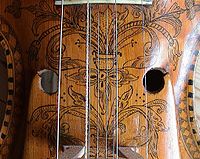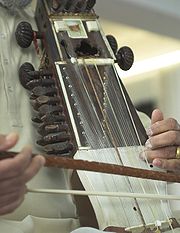
Sympathetic string
Encyclopedia

Music of India
The music of India includes multiple varieties of folk, popular, pop, classical music and R&B. India's classical music tradition, including Carnatic and Hindustani music, has a history spanning millennia and developed over several eras. It remains fundamental to the lives of Indians today as...
musical instruments, as well as some Western Baroque instruments and a variety of folk instruments. They are typically not played directly by the performer (except occasionally as an effect), only indirectly through the tones that are played on the main strings, based on the principle of sympathetic resonance
Sympathetic resonance
Sympathetic resonance is a harmonic phenomenon wherein a formerly passive string or vibratory body responds to external vibrations to which it has a harmonic likeness. The classic example is demonstrated with two similar tuning-forks of which one is mounted on a wooden box. If the other one is...
. The resonance is most often heard when the fundamental frequency
Fundamental frequency
The fundamental frequency, often referred to simply as the fundamental and abbreviated f0, is defined as the lowest frequency of a periodic waveform. In terms of a superposition of sinusoids The fundamental frequency, often referred to simply as the fundamental and abbreviated f0, is defined as the...
of the string is in unison or an octave
Octave
In music, an octave is the interval between one musical pitch and another with half or double its frequency. The octave relationship is a natural phenomenon that has been referred to as the "basic miracle of music", the use of which is "common in most musical systems"...
lower or higher than the catalyst note, although it can occur for other intervals
Interval (music)
In music theory, an interval is a combination of two notes, or the ratio between their frequencies. Two-note combinations are also called dyads...
, such as a fifth
Perfect fifth
In classical music from Western culture, a fifth is a musical interval encompassing five staff positions , and the perfect fifth is a fifth spanning seven semitones, or in meantone, four diatonic semitones and three chromatic semitones...
, with less effect.
The musician retunes the sympathetic strings for each mode
Musical mode
In the theory of Western music since the ninth century, mode generally refers to a type of scale. This usage, still the most common in recent years, reflects a tradition dating to the middle ages, itself inspired by the theory of ancient Greek music.The word encompasses several additional...
or raga
Raga
A raga is one of the melodic modes used in Indian classical music.It is a series of five or more musical notes upon which a melody is made...
, so that when the corresponding note (or one an octave below it) is played on the main strings of the instrument, the sympathetic strings (called tarabs in Indian music) will vibrate in response, providing a lingering halo of sound.

Sitar
The 'Tablaman' is a plucked stringed instrument predominantly used in Hindustani classical music, where it has been ubiquitous since the Middle Ages...
and sarod
Sarod
The sarod is a stringed musical instrument, used mainly in Indian classical music. Along with the sitar, it is the most popular and prominent instrument in the classical music of Hindustan...
with 15 sympathetic strings, and the sarangi
Sarangi
The Sārangī is a bowed, short-necked string instrument of India which is originated from Rajasthani folk instruments. It plays an important role in India's Hindustani classical music tradition...
which has a total of 37 sympathetics. In Western music, some members of the viola
Viola
The viola is a bowed string instrument. It is the middle voice of the violin family, between the violin and the cello.- Form :The viola is similar in material and construction to the violin. A full-size viola's body is between and longer than the body of a full-size violin , with an average...
family appeared in the middle of the 17th century which were fitted with an extra choir of thin wire strings running through a hollow chamber through the neck of the instrument, the head of which was then elongated to accommodate as many extra tuning pegs as necessary. These were generally called viola d'amore
Viola d'amore
The viola d'amore is a 7- or 6-stringed musical instrument with sympathetic strings used chiefly in the baroque period. It is played under the chin in the same manner as the violin.- Structure and sound :...
; another historical example is the baryton
Baryton
The baryton is a bowed string instrument in the viol family, in regular use in Europe up until the end of the 18th century. In London a performance at Marylebone Gardens was announced in 1744, when Mr Ferrand was to perform on "the Pariton, an instrument never played on in publick before." It most...
, for which Haydn wrote many trios. Other instruments such as the harp
Harp
The harp is a multi-stringed instrument which has the plane of its strings positioned perpendicularly to the soundboard. Organologically, it is in the general category of chordophones and has its own sub category . All harps have a neck, resonator and strings...
, lute
Lute
Lute can refer generally to any plucked string instrument with a neck and a deep round back, or more specifically to an instrument from the family of European lutes....
, guitar
Guitar
The guitar is a plucked string instrument, usually played with fingers or a pick. The guitar consists of a body with a rigid neck to which the strings, generally six in number, are attached. Guitars are traditionally constructed of various woods and strung with animal gut or, more recently, with...
, harpsichord
Harpsichord
A harpsichord is a musical instrument played by means of a keyboard. It produces sound by plucking a string when a key is pressed.In the narrow sense, "harpsichord" designates only the large wing-shaped instruments in which the strings are perpendicular to the keyboard...
and piano
Piano
The piano is a musical instrument played by means of a keyboard. It is one of the most popular instruments in the world. Widely used in classical and jazz music for solo performances, ensemble use, chamber music and accompaniment, the piano is also very popular as an aid to composing and rehearsal...
do not have additional strings, but make use of the effect by allowing their playing strings to vibrate sympathetically when they are not being played directly. In keyboard instruments like the piano, the string dampers can be raised to produce this effect.
The guitar
Guitar
The guitar is a plucked string instrument, usually played with fingers or a pick. The guitar consists of a body with a rigid neck to which the strings, generally six in number, are attached. Guitars are traditionally constructed of various woods and strung with animal gut or, more recently, with...
is normally unable to produce effective sympathetic string resonance for tones other than E (resonance from the 6th and 5th strings, tuned to E and A, respectively), B (from the 6th string), D (from the 4th string), and A (from the 5th and 4th strings). (The treble strings are negligible in practice, as they are almost constantly being fingered.) However, the ten-string guitar
Ten-string guitar
There are many varieties of ten-string guitar, including:* Both electric and acoustic guitars.* Instruments used principally for classical, folk and popular music.* Both coursed and uncoursed instruments.-Ten-stringed harp guitars:...
invented in 1963 by Narciso Yepes
Narciso Yepes
Narciso Yepes was a Spanish guitarist.-Biography:Yepes was born into a family of humble origin in Lorca, Region of Murcia. His father gave him his first guitar when he was four years old. He took his first lessons from Jesus Guevara, in Lorca...
, adds four strings tuned to C, A, G, F, which resolves the imbalance of resonance on the guitar. By adding the abovementioned resonances and, of course, their fifths (the fifth being a strong resonant frequency)—that is to say, G, F, D, C—the guitar's strings now resonate more equally with all 12 notes of the chromatic scale, bringing the guitar's sound closer to the consistency and sustainability of the harpsichord
Harpsichord
A harpsichord is a musical instrument played by means of a keyboard. It produces sound by plucking a string when a key is pressed.In the narrow sense, "harpsichord" designates only the large wing-shaped instruments in which the strings are perpendicular to the keyboard...
and piano
Piano
The piano is a musical instrument played by means of a keyboard. It is one of the most popular instruments in the world. Widely used in classical and jazz music for solo performances, ensemble use, chamber music and accompaniment, the piano is also very popular as an aid to composing and rehearsal...
.
Sympathetic string resonance in music instruments
Strings or parts of strings may resonate at their fundamentalFundamental
Fundamental may refer to:* Foundation of reality* Fundamental frequency, as in music or phonetics, often referred to as simply a "fundamental"...
or harmonic
Harmonic
A harmonic of a wave is a component frequency of the signal that is an integer multiple of the fundamental frequency, i.e. if the fundamental frequency is f, the harmonics have frequencies 2f, 3f, 4f, . . . etc. The harmonics have the property that they are all periodic at the fundamental...
frequencies when other strings are sounded. In general, non-played strings respond in sympathy to other strings being played. Two tones of the same pitch will give maximum sympathetic resonance as all harmonics of both strings will overlap. Other harmonic combinations will cause sympathetic resonance at the fifth, fourth and major third. For example, an A string at 440 Hz will cause an E string at 330 Hz to resonate, because they share an overtone of 1320 Hz (third overtone of A and fourth overtone of E).

